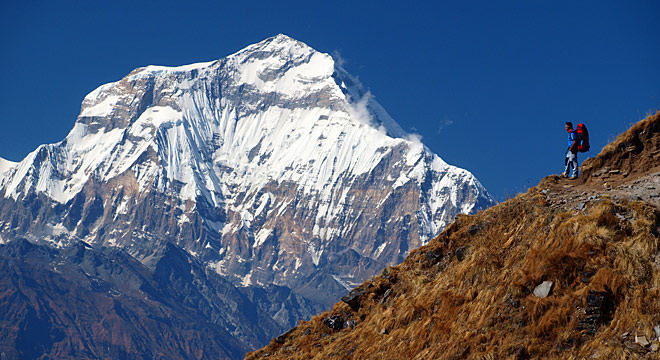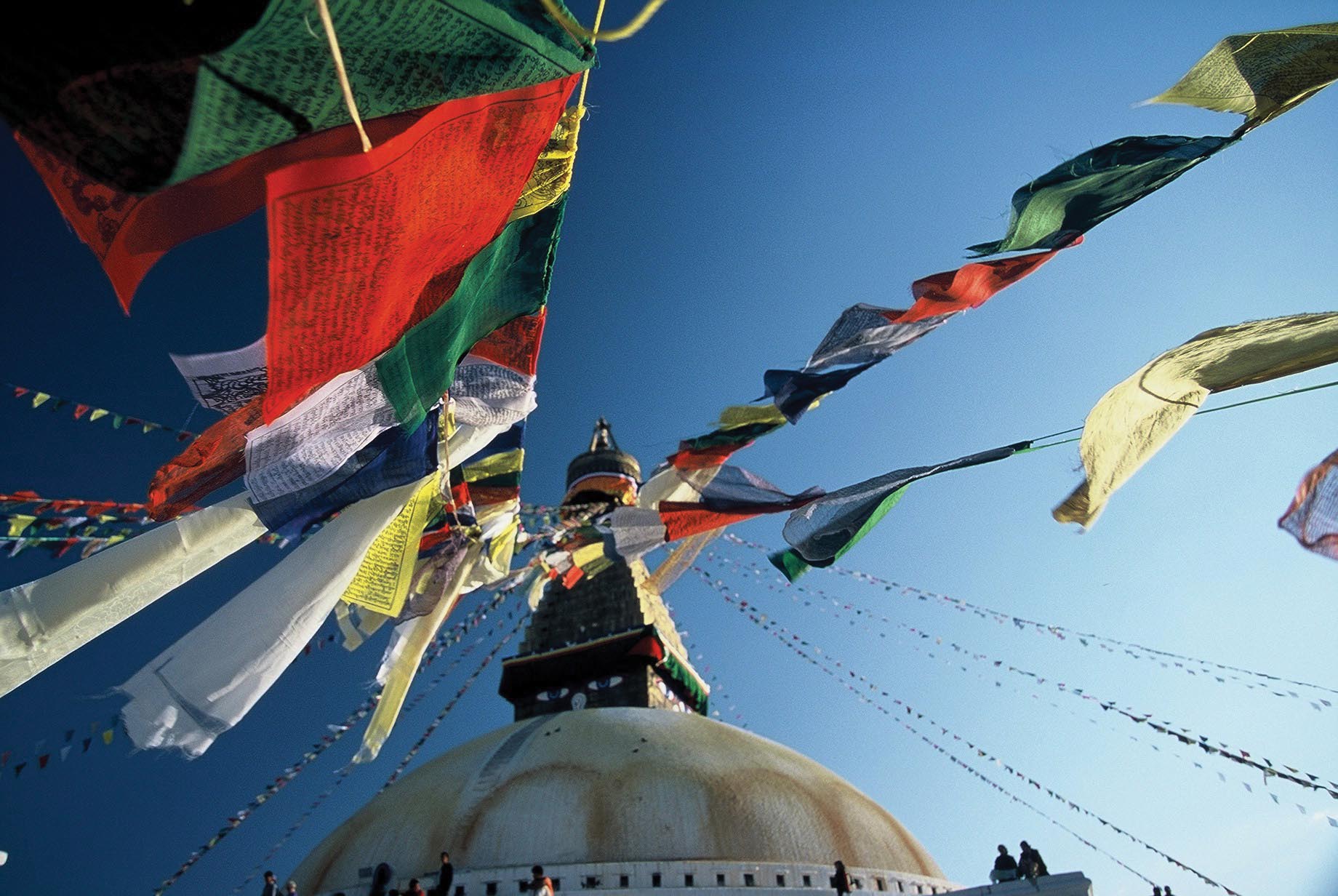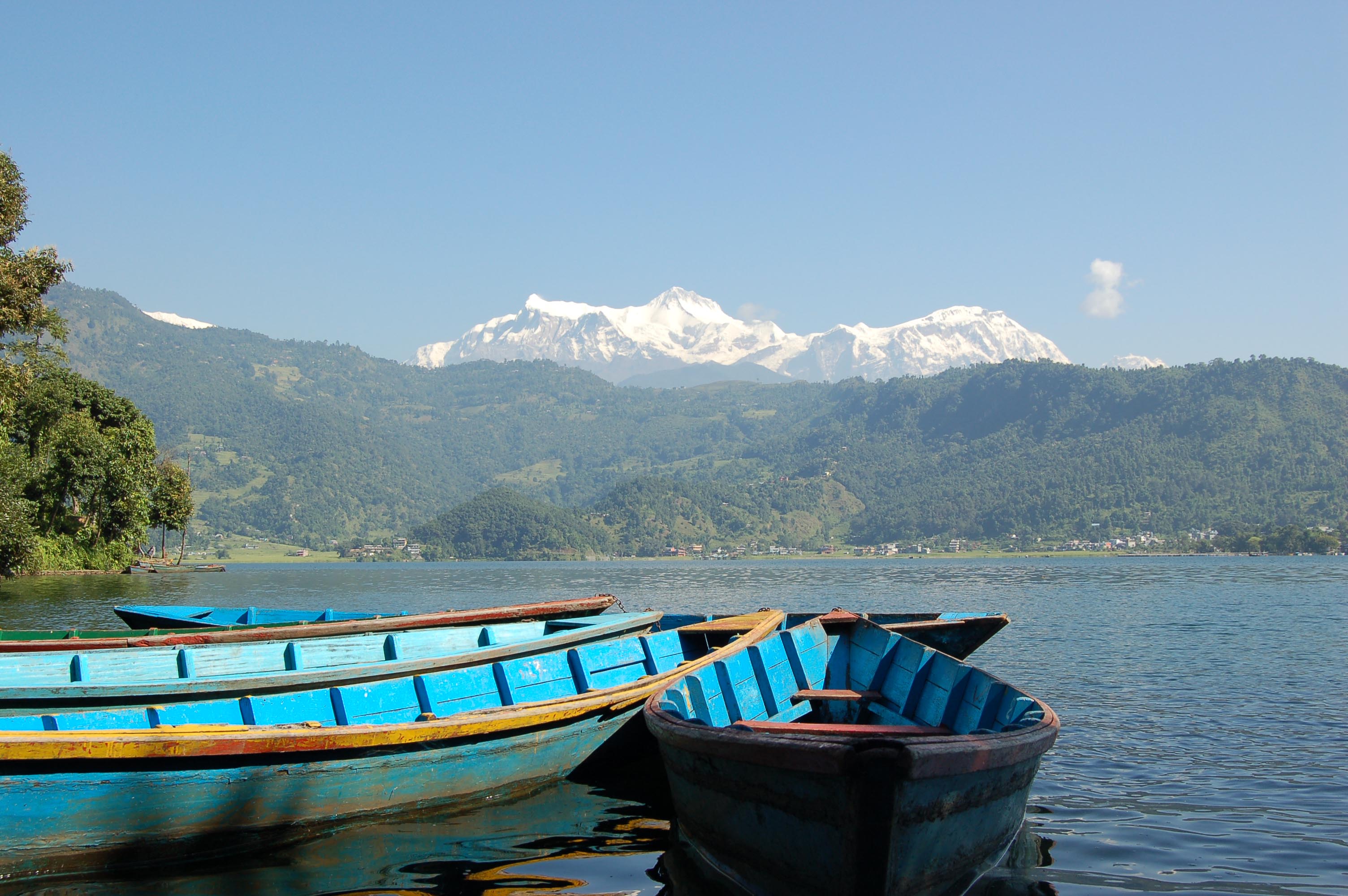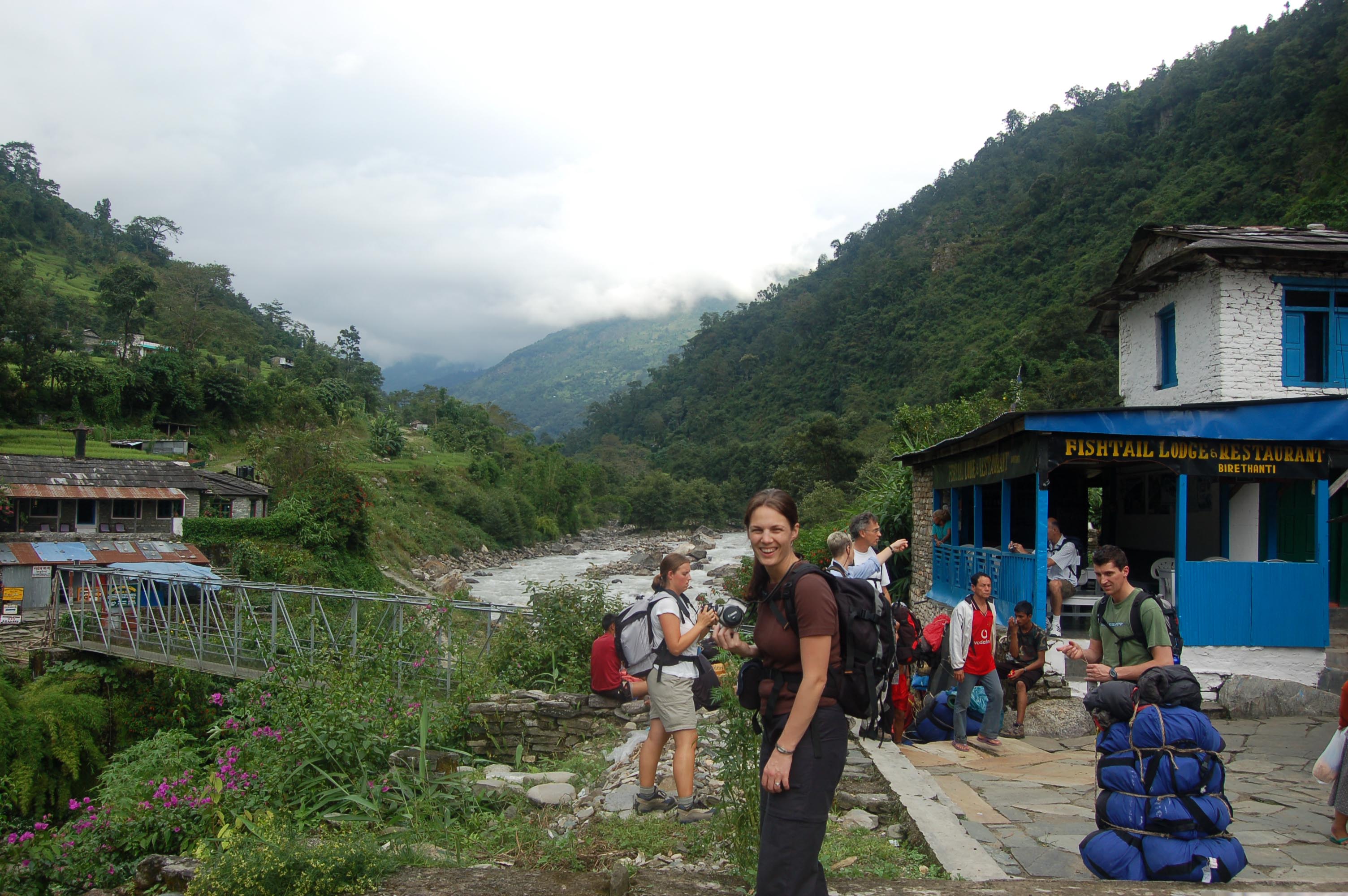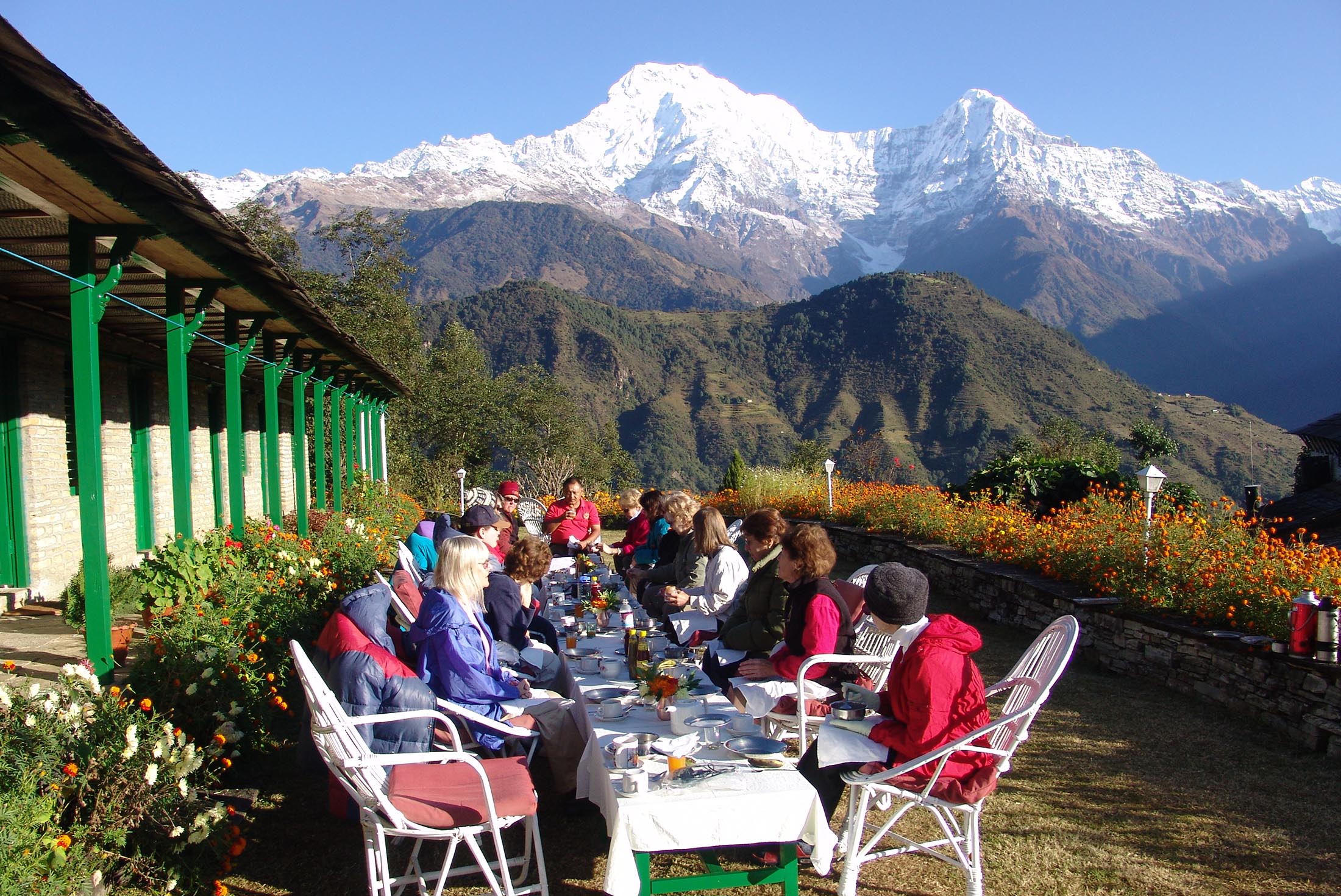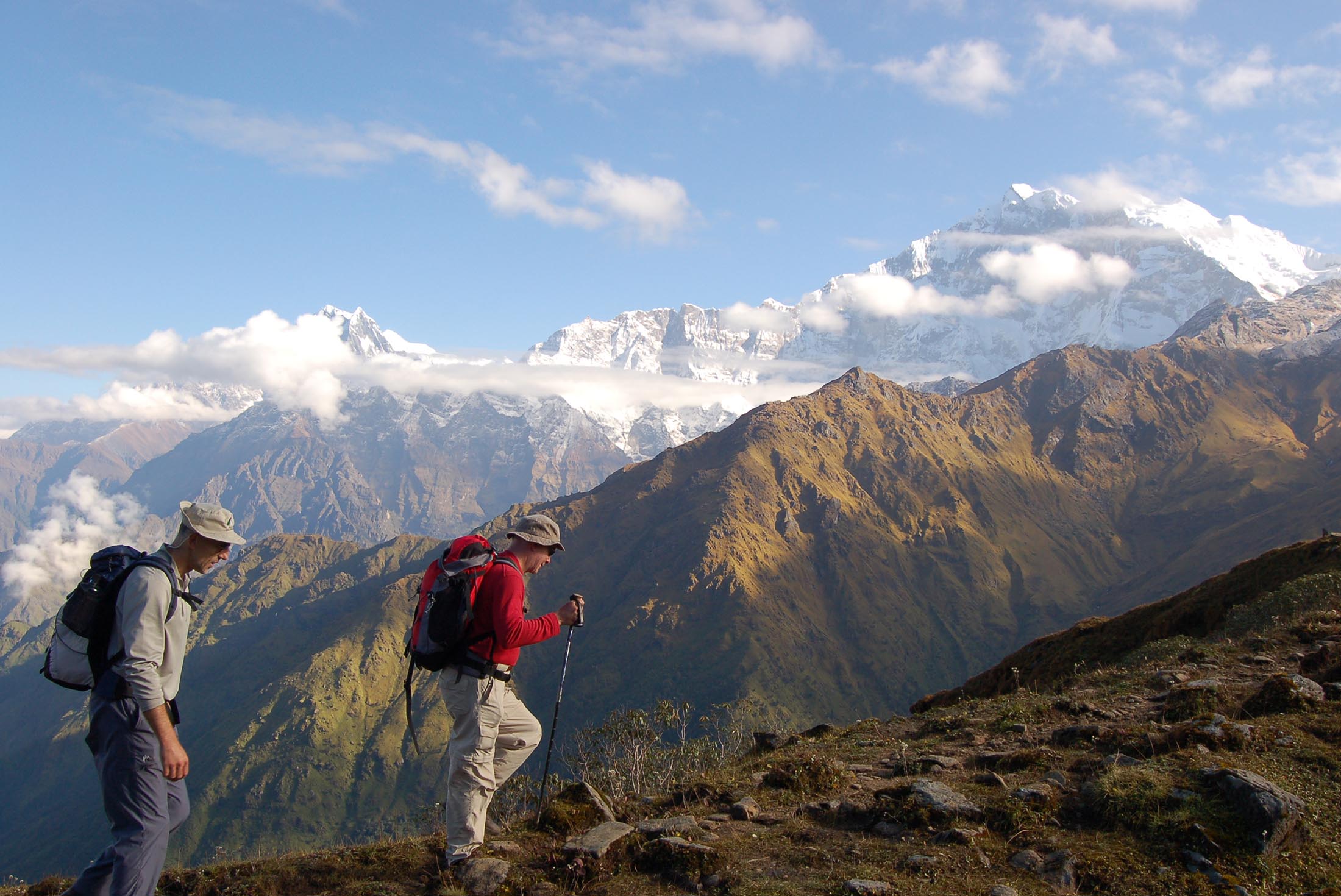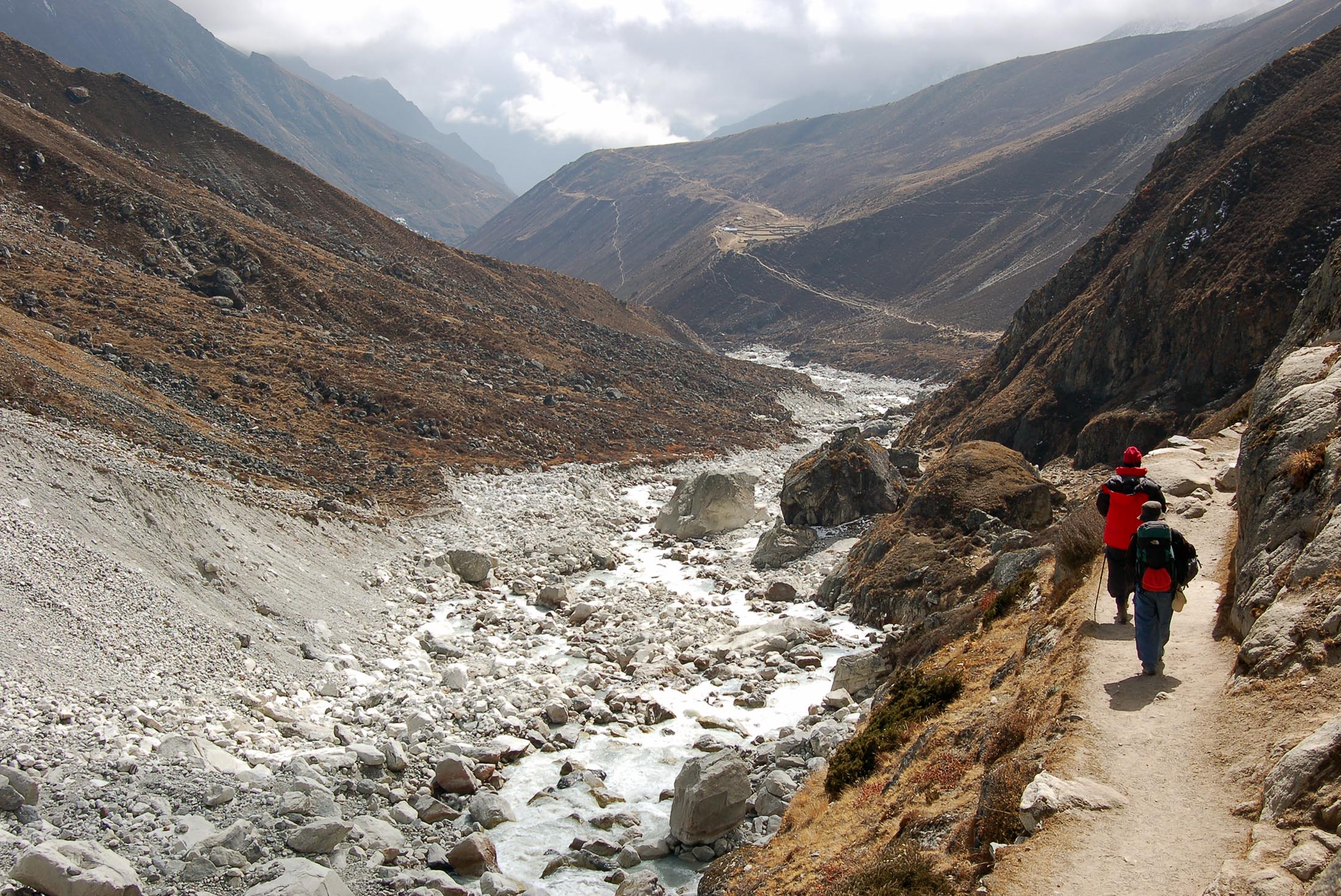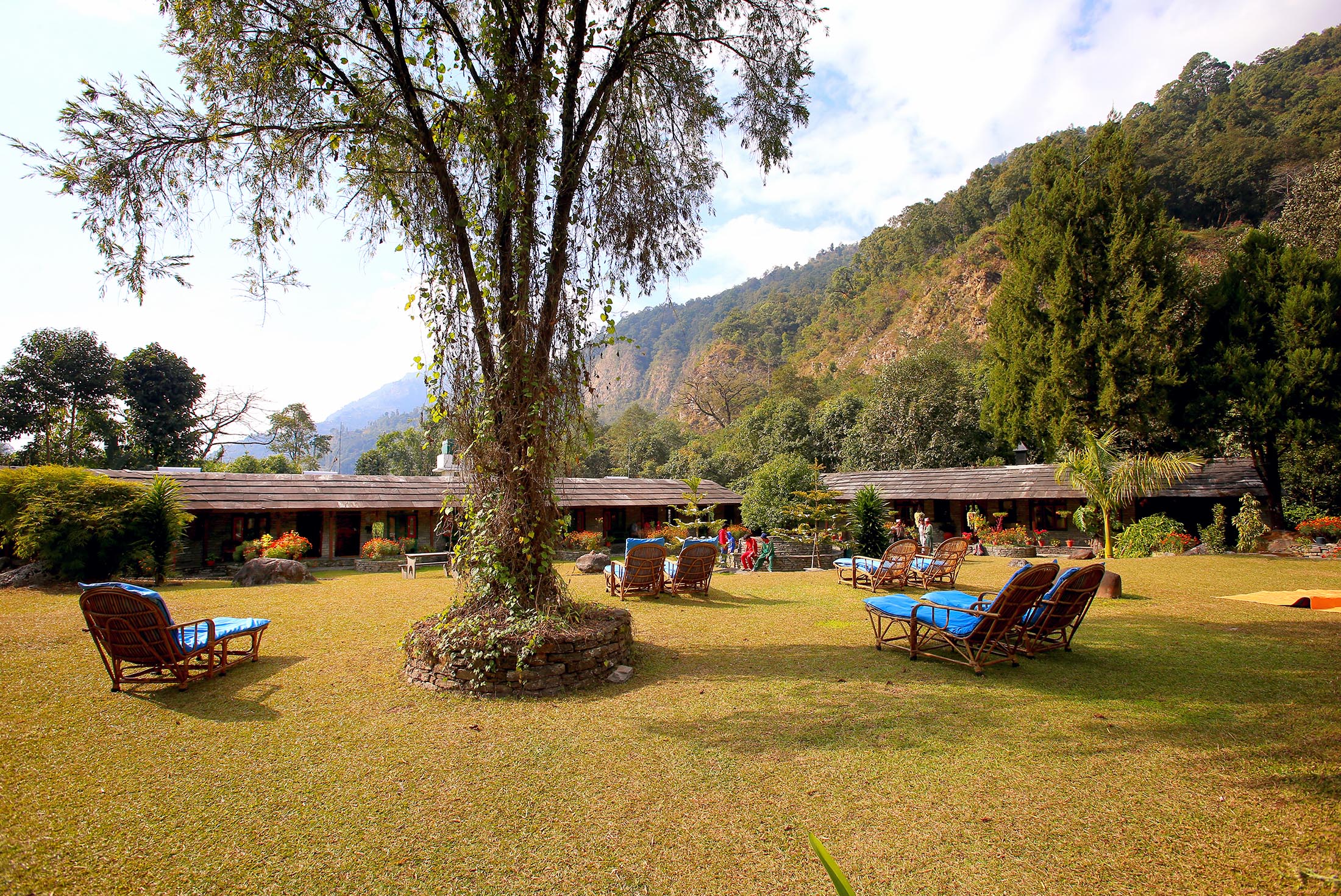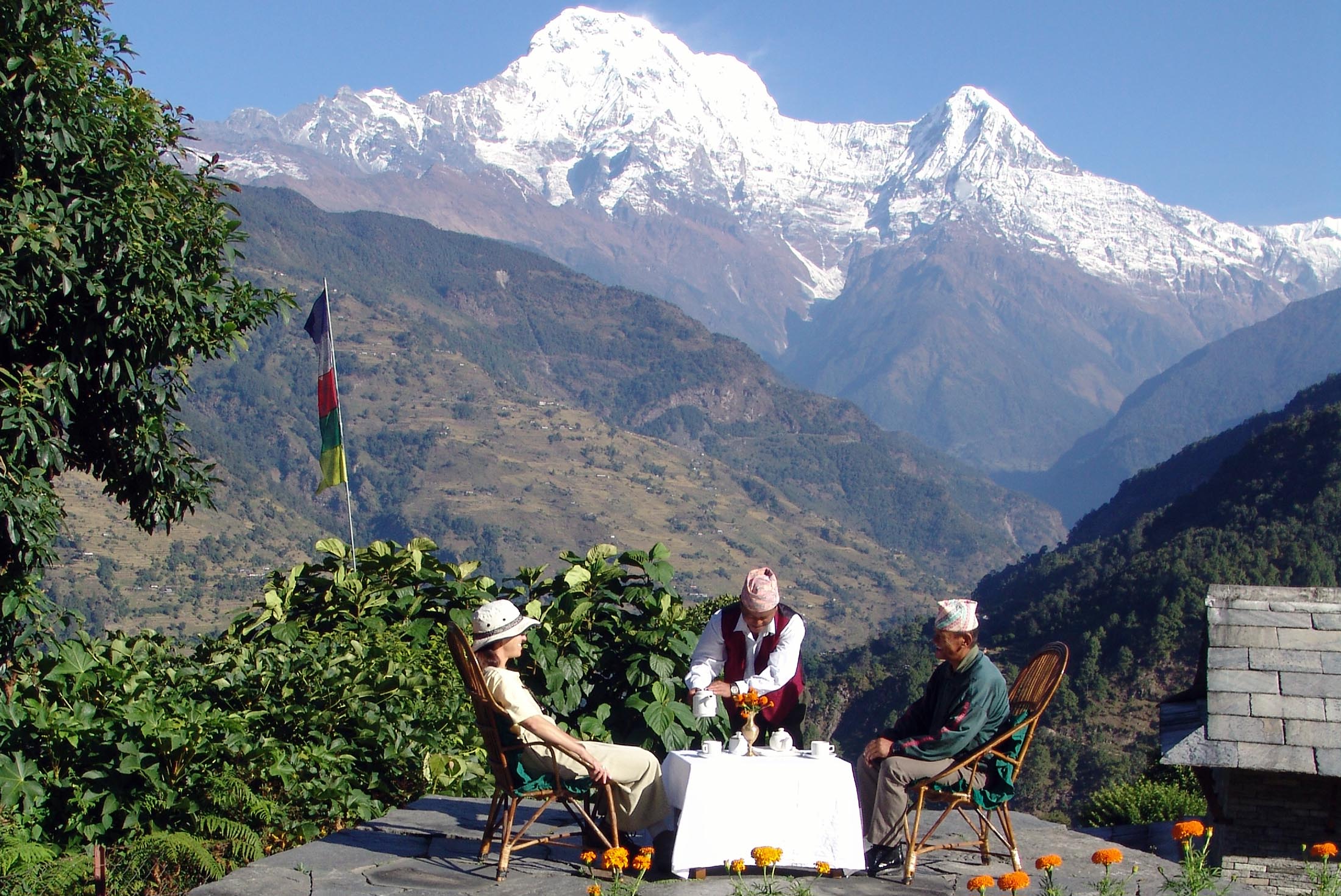- Trekking in Nepal usually requires a little ‘roughing it’ here and there – but not on this itinerary. Stay in our high-end mountain lodge feature stays with atmospheric settings and comfortable living quarters
- Set eyes on some of the world’s most spectacular mountain scenery, hiking through small villages and oak and rhododendrons forests
- Discover the fascinating mix of ethnic cultures living side by side in Ghandruk. Tour the Garung Cultural Museum, Annapurna Conservation Area Project and the Ghandruk Monastery
- Embark on a boat trip around beautiful Fewa Lake, stopping in at Talbarahi Temple and the International Mountain Museum
- Enjoy a farewell dinner in Kathmandu’s excellent Utsav restaurant replete with local cultural entertainment
- Your 5 nights in our mountain lodge 'feature stays' combine spectacular panoramic vistas of the Annapurnas with comfortable cozy rooms
23 Aug 2021
Annapurna in Style
PHAT
Validity: 01 Jan 2020 to 31 Dec 2021
Introducing Peregrine’s latest Annapurna adventure, a unique itinerary that combines luxury mountain accommodation with all the hallmarks of a classic Nepal trek. Discover a stunning wilderness of alpine ridges, holy lakes and sensational mountain views. The Annapurna ranges, towering in excess of the magical 8000-metre height, is the great attraction, along with the beautiful fish-tail peak of Machapuchhare. Make the scenic flight to Pokhara; embark on awe-inspiring treks to Birethanti, Majhgaon and Lumle; explore the culturally and ethnically diverse mountain community of Ghandruk; and cruise across gorgeous Fewa Lake. Enjoy a touch of comfort at every step of the journey, staying in some of the finest lodges in the Himalayas.
Peregrine
Trekking
On foot,Plane,Private van
4
The Trekking Day & the Trekking Team The Group Leader (Trek Leader) A group leader will accompany every trek. The trek leader's main function is to look after the welfare of group members. Our leaders are all experienced trekkers chosen not only for their knowledge of the Himalaya, but perhaps more importantly, for their "people skills". They are there to ensure you have a safe, informed and enjoyable trek. They are English-speaking and all our current leaders hold internationally recognised first-aid certificates. Trekking Guides (Sherpas, Assistant guides) The trekking guides accompany the group during the day to ensure you are following the right path and to assist you where required. The assistant guide ratio is usually one to every six trekkers for treks going above 4500 metres. (below 4500m is one to eight). Do not feel obliged to keep in a group all the time. You may wish to linger through a particularly beautiful rhododendron forest, visit a village school or move off the trail to bird-watch; please do so. We wish you to have as much freedom and flexibility as possible, but please do advise the guides of your whereabouts. Our guides have a basic knowledge of the English language - and will be happy to try to teach you a few words of the local one. The Nike and Porters The Nike is the foreman of the porter group. Our porters have enjoyed many years working with our groups. Locally based near the starting point of our treks, they are responsible for the carrying of the equipment and food. A tough job but one always done with a smile. All our porters are supplied with additional equipment and clothing by us to ensure they are adequately protected on our treks. The Trekking Group Our trekking groups are truly international. You can expect people from Australia, New Zealand, America, U.K., Canada and Europe to be in your group. Ours are small group tours with an average of 10 members per group, with a usual maximum of 16 members. Group members may vary considerably in age, profession and background. The Trekking Day The day usually begins between 6.30 am and 7.30 am. After you have packed all your gear into your kitbag, breakfast will be ready. While you are eating, the crew members will make up the loads for the porters. You will often be on the trail by 7.30 am, though at higher altitudes the start is usually later, as we wait for the sun to warm the air a little. There is plenty of interest along the trail and there is no need to rush. Become aware of all that is around you, and become involved. The day has been planned so that you have plenty of time. The porters will not be in a hurry with their loads, and theirs is a good pace to judge yours by. Faster walkers keep an eye on the guides so that you do not overshoot lunch and overnight stops! At a suitable spot, about 11.30 am, we stop for lunch for a couple of hours. This is a good time to relax and rest - or even wash some socks, etc., so that they can dry during the afternoon walk (relatively easy at lower altitudes, progressively harder higher up). Sterilised water is provided for washing your hands prior to all meals. The afternoon walk follows a similar pattern to the morning; it is often shorter and your lodge is usually reached between 3 pm and 4 pm. There is plenty of time to relax or explore the surrounding area until the evening meal is served about 6.30 pm. After dinner there is time to chat, read or perhaps enjoy a game of cards with our crew. Most members are asleep by 9 pm. This comfortable living pattern is amazingly refreshing, and there are those who class trekking as a therapeutic experience! The Trekking Menu While in lodges, menus are a mixture of local, Asian and western cuisine. The emphasis is on a healthy variety, with many meals given a local touch. Breakfast options consist of porridge or muesli, with local-style breads, then eggs, jam, peanut butter, tea, coffee, and hot chocolate. For lunch, most prefer a lighter meal, maybe a fresh salad with tinned fish and cheese, followed by fresh or tinned fruit with cordial juice and tea. For dinner, if you're hungry a three-course meal with soup, a main course of rice, dhal, vegetables, a mild curry, followed by chocolate cake, tea, coffee or hot chocolate will round off a great day. All meals are cooked on kerosene stoves and are prepared to strict hygienic standards. Will I Walk In Snow? This question is frequently asked. Snow levels will vary, largely with the time of the year and with individual weather conditions, and to some extent the terrain. It is unlikely - but we cannot guarantee it! - that lower altitude treks (to 3000 metres/10,000 feet) will encounter snow, even in the winter months. Other treks above that altitude may at any time of the year, although the likelihood is less during the warmer months, whilst higher altitude treks (above 4000 metres/15,000 feet) quite likely will encounter some, and climbing trips definitely will. If walking in or near snow it is especially important that you have good sunglasses and gaiters. It does not snow in Kathmandu
Shangri La Hotel
Lazimpat Road
Lazimpat
Kathmandu
44600
NEPAL
Phone: +977 14412999
The Shangri La Hotel in Kathmandu has been home to Peregrine trips for many years. The hotel offers 24 hour reception, a cafe, restaurant and bar as well as lush grounds with a small swimming pool. All guest rooms are fitted with tea and coffee making facilities, a room safe, free wi-fi, satellite TV, A/C. the hotel is a convenient 10-minute walk from Thamel and Durbar Marg. It is approx 6km to Tribhuvan International Airport.
An arrival transfer is included in the cost of your trip. Please ensure that we have been advised of your correct flight details into Kathmandu by either yourself or your travel agent. A representative will be at Kathmandu airport to meet your flight and transfer you to your hotel. If you cannot see your representative, please call our local operator (details on your itinerary) for assistance In cases of your transfer driver not being at the aiport upon arrival, please contact our local office in Kathmandu. +977 9802081131 +977 9801123617 Taxi information: There are two pre-paid taxi booths inside the terminal, one on each side as you exit the baggage claim area. They have fixed rates of NPR600 to anywhere in the Thamel area from 6am-8pm and NPR800 from 8pm-6am. Otherwise you will need to bargain hard from the taxi rank outside of the airport - aim for NPR500. The drive into Thamel takes 30 to 40mins dependent on the traffic.
Shangri La Hotel
Lazimpat Road
Lazimpat
Kathmandu
44600
NEPAL
Phone: +977 14412999
The Shangri La Hotel in Kathmandu has been home to Peregrine trips for many years. The hotel offers 24 hour reception, a cafe, restaurant and bar as well as lush grounds with a small swimming pool. All guest rooms are fitted with tea and coffee making facilities, a room safe, free wi-fi, satellite TV, A/C. the hotel is a convenient 10-minute walk from Thamel and Durbar Marg. It is approx 6km to Tribhuvan International Airport.
1. A single supplement is available to purchase on this trip. Due to the nature of trekking tea houses, a single room is not available for the trekking section of this trip (nights 3-6) 2. Please bring 2 passport size photographs for your trekking permit to the group meeting. 3. A good level of fitness is required. You will be trekking on hilly terrain, generally on well-defined paths, walking about 3-6 hours per day.
All Peregrine Adventures group trips are accompanied by one of our group leaders. The aim of the group leader is to take the hassle out of your travels and to help you have the best trip possible. Peregrine Adventures endeavours to provide the services of an experienced leader however, due to the seasonality of travel, rare situations may arise where your leader is new to a particular region or training other group leaders. Your leader will provide information on the places you are travelling through, offer suggestions for things to do and see, recommend great local eating venues and introduce you to our local friends. While not being guides in the traditional sense you can expect them to have a broad general knowledge of the places visited on the trip, including historical, cultural, religious and social aspects. At Peregrine Adventures we aim to support local guides who have specialised knowledge of the regions we visit. If you were interested in delving deeper into the local culture at a specific site or location then your leader can recommend a local guide service in most of the main destinations of your trip.
Many national governments provide a regularly updated advice service on safety issues involved with international travel. We recommend that you check your government's advice for their latest travel information before departure and ensure that your travel insurance covers you for all areas your itinerary covers. Please refer to our website's safety page for links to major travel advisories and updates on safety issues affecting our trip. We strongly recommend the use of a neck wallet or money belt while travelling, for the safe-keeping of your passport, air tickets, cash and other valuable items. Leave your valuable jewellery at home - you won't need it while travelling. Many of our hotels have safety deposit boxes, which is the most secure way of storing your valuables. A lock is recommended for securing your luggage. Your leader will accompany you on all included activities, however during your trip you'll have some free time to pursue your own interests, relax and take it easy or explore at your leisure. While your leader will assist you with the available options in a given location, please note that any optional activities you undertake are not part of your Peregrine itinerary, and Peregrine Adventures makes no representations about the safety of the activity or the standard of the operators running them. Please use your own good judgement when selecting an activity in your free time. Please also note that your Leader has the authority to amend or cancel any part of the trip itinerary if it's deemed necessary due to safety concerns. For more details on the type of conditions and safety standards you can expect on your trip, please refer to Peregrine Adventures' operational safety policy on our website. We recommend that you take a moment to read through this information before travelling, and would appreciate any feedback on how well it's being implemented in the field:
http://www.peregrineadventures.com/safety-updates
STRIKES: Demonstrations and protests are common in Nepal, with strikes regularly occurring that may result in curfews or roadblocks being enforced at short notice. At these times, businesses may close and vehicles may not be allowed on the roads. You should avoid any demonstrations or political gatherings and follow local advice, including that of your leader in the event of any disruptions. PETTY THEFT & CRIME: Pickpocketing and other petty theft is common, especially in places where tourists or foreigners frequent. Take care when walking around at night. Avoid walking on your own and don’t carry large sums of cash. Keep valuables in a hotel safe if possible. Bars and restaurants now close at midnight as part of a government crackdown on illegal activities. Foreigners remaining in bars and clubs after hours have been detained by the police. Police have increased their presence in Thamel and Durbar Marg, popular tourist districts in Kathmandu, in an effort to reduce crime in these areas. You should seek out police if you have been robbed or affected by any crime. ALTITUDE: Altitude sickness is a risk, including on the Annapurna, Langtang and Everest Base Camp treks. Please make sure you familiarise yourself with signs and symptoms before you depart and monitor your own health during your trek. INSURANCE: Make sure your insurance covers you for your intended activities, including travel and trekking above 3000m if this is included on your itinerary, mountain rescue services and helicopter evacuation costs. FESTIVALS: Travelling in Nepal during Holi Festival (28-29 March 2021, 27-28 March 2022), can at times be dangerous due to revellers consuming intoxicating substances. The day is often associated with physical violence and danger. Your leader will advise you and your group on what places to avoid on this day and it may even be necessary for us to alter your itinerary for the day to avoid putting you or your group leader in a high-risk situation. Travelling during the Hindu festival Diwali (4 November 2021, 24 November 2022) can also be dangerous. During this time there are many displays of fireworks in the streets. It can be very noisy for several days and there is also a lot of pollution caused by the fireworks. As there are no restrictions on buying fireworks there are often injuries caused by people exploding them inappropriately. During this festival, your leader may be required to alter your itinerary to avoid any dangerous areas to avoid putting the group at risk. INTERNAL FLIGHTS: There have been a number of air accidents in Nepal. We only use airlines that have passed strict safety audits for included internal flights in Nepal, including Buddha Air, Yeti Air & Tara Air.
Hotels in Kathmandu generally have excellent wi-fi connections. Most hotels offer free wi-fi in public areas, with some also offering in room wi-fi. Most restaurants and cafe's in Kathmandu and Pokhara have free wi-fi connections. Just ask the wait staff when ordering and keep an eye out for the international symbol for wi-fi. Ker & Downey Lodges do not have wi-fi or internet. All the better to enjoy the beauty of this part of Nepal.
As a general rule most countries expect that your passport has a minimum of 6 months validity remaining. Please ensure the name on your passport matches the name on your booking and airline tickets. Your passport details are required to complete your booking. Your consultant will contact you when this is required. Take a copy of the main passport pages and other important documents with you, and leave another copy at home with family or friends. PASSPORT You will need a valid passport to travel internationally. As a general rule, most countries require that your passport has a minimum of 6 months validity remaining. Your passport details are required to complete your booking. Please ensure the name on your passport matches the name on your booking and airline tickets exactly and contact us immediately if there are any errors. We recommend taking copies of the main passport pages and other important documents with you as well as leave copies at home with family or friends. VISAS Visas are the responsibility of the individual traveller. Entry requirements can change at any time. It is important that you check your government's foreign travel advisories along with the consular website of the country or countries you are travelling to for the most up to date information specific to your nationality and circumstances. Please be aware that not all visa information found online from other sources may be valid while COVID-19 restrictions are in place. Visas can take several weeks to process, so make sure you research the requirements as soon as you have booked your trip to allow for obtaining any necessary documents as well as the application and processing time. Your booking consultant can advise on a visa processing service or you can apply yourself directly through a consulate. COVID-19 Entry and Exit Requirements Below you will find general visa advice about the destinations on your trip. Due to constantly evolving COVID-19 requirements and restrictions, please refer to your government's foreign travel advice for the most up to date information.You may also refer to our travel alert page for more info https://www.intrepidtravel.com/en/travel-alerts Make sure you are familiar with the current border measures and entry requirements as these are quite complex and changing frequently without notice. Please also ensure you have a travel insurance policy that covers your travels as well as medical or COVID-19 related expenses within the country. RETURN TRAVEL Please ensure you stay up to date with any current testing or quarantine requirements for returning to your home country or transiting through other destinations after the completion of your tour. We are able to help facilitate taking a COVID-19 test while on trip. Please ensure you have funds available to cover the cost of this test which will be payable directly to the testing site. Your Intrepid Tour Leader will provide more details at the group meeting as well as assist with booking appointments for all travellers who need to be tested. NEPAL: All foreign nationals (except Indian passport holders) require a visa to enter Nepal. Visas are obtainable from embassies abroad, land borders (including borders with India & Tibet), and on arrival at Kathmandu's Tribhuvan Airport. Getting a visa at the airport or land borders can sometimes take time due to long queues. There have been instances when travellers are asked to show proof of exit from the country, ie flight tickets. You may also need to provide two passport photos and the following fees in US dollars (subject to change, cash only). Other currencies are also accepted although rates may differ. The following costs were correct at time of writing: - Multi entry visa valid for 15 days - US$30 - Multi entry visa valid for 30 days - US$50 - Multi entry visa valid for 90 days - US$125 Your visa application form may require you to state the dates on which you enter and exit that country. Please note we suggest you list your date of entry a few days before, and date of exit a few days after your intended dates in case you encounter any delays or problems en route. To help calculate the exact dates of these crossings we have found the website www.timeanddate.com to be very useful.
Trekking in Nepal usually requires a little ‘roughing it’ here and there – but not on this itinerary. Stay in our high-end mountain lodge feature stays with atmospheric settings and comfortable living quarters
Set eyes on some of the world’s most spectacular mountain scenery, hiking through small villages and oak and rhododendrons forests
Discover the fascinating mix of ethnic cultures living side by side in Ghandruk. Tour the Garung Cultural Museum, Annapurna Conservation Area Project and the Ghandruk Monastery
Embark on a boat trip around beautiful Fewa Lake, stopping in at Talbarahi Temple and the International Mountain Museum
Enjoy a farewell dinner in Kathmandu’s excellent Utsav restaurant replete with local cultural entertainment
Your 5 nights in our mountain lodge 'feature stays' combine spectacular panoramic vistas of the Annapurnas with comfortable cozy rooms
This trip is a short trek with day walks at altitude, staying in high end Nepali mountain lodges. Physical preparation before your trek will be a definite advantage. Please carefully read all trip information to gauge your fitness and suitability for this trip.
AIR POLLUTION: Air quality in Nepal can be poor, especially in winter. Some towns, including Kathmandu, experience very high levels of seasonal smog and heavy particulate pollution. Seek medical advice if you're concerned about the effects of air pollution. ALTITUDE SICKNESS: Travellers to altitudes higher than 2,500m are at risk of altitude sickness, also known as acute mountain sickness (AMS). This can be life-threatening and affect anyone, even people who are very physically fit. There is a higher risk for those who have had altitude sickness before, who exercise or drink alcohol before adjusting to the altitude, or who have health problems that affect breathing. If your tour travels to high altitude, see your doctor for advice specific to you and your situation before you depart. It is important to be aware of the normal altitude symptoms that you may encounter BUT NOT worry about: - Periods of sleeplessness - Occasional loss of appetite - Vivid, wild dreams at around 2500-3800m in altitude - Unexpected momentary shortness of breath, day and night - Periodic breathing that wakes you occasionally - Blocked nose - Dry cough - Mild headache If you are feeling nauseous, dizzy, or experience other symptoms, please be sure to let your group leader know immediately so that we can monitor your condition. Please be aware that should your group leader deem it unsafe for you to continue trekking at any time, they will arrange for you to descend to a lower altitude. Please read the following document carefully and, during your trip, utilise the table on the back daily to record your own perspective of your general health and any symptoms you may experience: https://www.intrepidtravel.com/altitude-sickness On some days this trip may ascend faster than commonly published recommended ascent rates at altitude. However, based upon an assessment by our external safety and medical advisors, and in conjunction with our own risk assessments, we consider that the ascent rate is acceptable due to the additional safety measures that are in place for our customers. If you have concerns about this, please speak to your booking representative. All our leaders in the Himalayas are trained in the use of a PAC bag (Portable Altitude Chamber) and this is carried on all trips which go above 4,200m. The PAC bag is used in an emergency only to treat altitude sickness in the mountains. A First Aid kit is carried with the group and all our leaders are First Aid trained. Please ensure that your travel insurance policy does cover you up to the maximum altitude on this trip, and includes helicopter evacuation. Please take proof of this with you on the trip, as you will need to show it to the leader. MOSQUITO-BORNE ILLNESSES: Malaria is a risk in some areas of Nepal including Chitwan National Park. Dengue fever and Japanese encephalitis also occur, including on occasion in Kathmandu. Protect yourself against insect bites by wearing adequate protection, including repellent. MEDICAL FACILITIES AND TREATMENT: Medical facilities in Nepal are very limited, particularly outside Kathmandu. In Kathmandu, treatment at international-standard clinics is expensive and up-front payment for services is generally required. Make sure you have adequate travel health insurance and accessible funds to cover the cost of any medical treatment, including evacuation by helicopter.
FOOD IN NEPAL: In Kathmandu and Pokhara there are plenty of restaurants and cafes for all tastes and budgets. For a glimpse at what traditional Nepali cuisine entails, check out our guide here: https://www.intrepidtravel.com/adventures/guide-to-nepali-cuisine/ Vegetarians are well catered for, with most restaurants and cafes providing veg and non-veg options. All main meals are included while on trek. Please note that this does not include alcohol, bottled water, soft drinks or snacks. Keep in mind that prices will be higher the higher you go! A sample menu for what is included on trek is below: Breakfast - toast, Tibetan bread, chapatti, pancakes, eggs or porridge/muesli Lunch - dal bhat (rice with lentils or curry), fried rice, mixed vegetable curries, or noodles (fried or in soup, veg or non-veg) or pasta (veg or non-veg) Dinner - soup (veg), pasta (veg or non-veg), noodles (fried or in soup, veg or non-veg) or dal bhat (rice with lentils or curry), fried rice, mixed vegetable curries, or momos (dumplings, veg or non-veg) Tea and coffee is generally included with meals. You are of course more than welcome to eat at other restaurants or tea houses during your trek, but please note these meals will be at your own expense and no refund will be provided. ALCOHOL & CAFFEINE: Alcohol and trekking don't mix. We highly recommend that you limit your alcohol consumption in Kathmandu prior to your trip. Celebrate your achievements after your trek. Both alcohol and caffeine increase dehydration. Limit your intake of both when hiking at high altitudes.
NEPAL: The official currency of Nepal is the Nepali rupee (NPR). Its symbol is often displayed as Rs. USD is also widely accepted in Nepal. ATMs can only be found in Kathmandu, Pokhara, and Bhaktapur. Make sure you carry sufficient cash to cover your needs when travelling outside of these cities. Money exchange facilities are available in Kathmandu, Namche, Pokhara, Chitwan (only outside the park), and Bhaktapur. Credit cards are not widely accepted. The Government of Nepal has banned the import, export, and use of 500 and 1000 Indian rupee notes in Nepal. You should ensure you are not carrying these notes on arrival in Nepal as they will be confiscated and you may be fined. Please note that most establishments in Asia will not accept foreign currency notes that are old, torn, or faded and they can be very difficult to exchange or extra fees added when exchanging at banks. Please ensure that you have new, clean notes. Before departing on a trek, make sure you have enough Nepalese currency to purchase meals and drinks, in the smaller denominations where possible, as there are no ATMs and larger notes (such as 1000R) can be difficult to change. Although the culture of tipping may not be part of your own culture, it is nonetheless part of the culture in this area of the world and it is often the way some people supplement their earnings. Tipping has become an accepted part of tourism in Asia. On our trips your tour leader can advise you on this matter; however, as a guideline we would recommend a tip of 5-10% in restaurants. The bellboys at hotels will appreciate a small tip for carrying your bags. Taxi and rickshaw drivers do not expect a tip. If you are unhappy with a service, of course, you are under no obligation to leave a tip. However, if the service has been satisfactory, a tip is always appreciated....with a smile! While on trek, we suggest a group tip of US$4 per person per day for your trekking crew. At the end of the trek, your trek leader will collect and distribute the group tip to all members of the trekking crew including additional guides, cooks and porters. Please note that this group tip is not designed to provide a tip for your trek leader. At the same time if you have any items of clothing, pens, etc. that you do not wish to take home with you, some members of your trekking crew will be very happy to receive these things. Your tour leader (or trek leader) works hard to ensure you have a great trip, so please don't hold back if you would like to reward them for their services. You can tip them individually or make a group presentation at the end of the tour. The suggested amount is US$3-US$4 per person, per day.
PACKING, PACK WEIGHT, DAY PACK & PORTERS Peregrine provides a duffel bag to carry your trekking gear. The weight limit per person is 10kg each. Porters are legally limited to carrying 20kg max on trek. Please keep the weight and bulk of your trek bag to a minimum by bringing clothes made from lightweight material. Don't pack too much clothing; one or two changes will be all you need. However, as the weather conditions in the Himalayas are often unpredictable, be prepared for all eventualities, be it rain, unseasonable cold or heat. For the trek all of your gear should be packed into plastic bags to protect it from the weather - dry clothes are essential for your comfort. Your trek leader will assist you if you are unsure. A medium size, comfortable day-pack is required for you to carry personal personal items such as camera, water bottle, valuables, sunscreen, hat etc... You only need to carry your day pack. TREKKING EQUIPMENT Trekking boots (broken in) Waterproof 3/4 season jacket and trousers (can be hired/purchased in Kathmandu) Evening footwear (ie sneakers or boots) Several pairs of good quality socks T-Shirts - highly recommended are synthetic t-shirt styles that wick away moisture Thermal underwear/layers Down jacket (can be hired/purchased in Kathmandu)* Warm mid layers (fleece/micro fibre) Trousers - lightweight, loose fitting, trekking trousers. Shorts or skirt for summer Tracksuit or fleece pants for evenings Sleeveless fleece and extra layers for winter departures Warm hat and sun hat Scarf/neck warmer Gloves and mitts - waterproof and warm Sunglasses with UV protection Head torch (spare batteries) Sunscreen and Lip Balm Light weight towel Personal first aid kit Biodegradable wet wipes/toilet paper Hand sanitizer gel Trail mix/nuts/muesli bars Down Jackets - We have a limited number of down jackets stored in country to use free of charge during the trip. These are subject to availability and size requirements. Daypack - The daypack you select must have the capacity for the items you may be carrying on a day's walk: rain jacket, trousers, warm clothing, water bottle, camera equipment, washing items and other personal effects. A hip/waist strap provides additional comfort. You should consider day packs of at least a 30 to 40 litre capacity. WATER BOTTLE: Consider bringing your own water bottle to refill along the way. The sale of bottled water contributes to an enormous environmental problem around the world. In addition to the water in bottles, the production of a 1 litre plastic bottle takes 2 litres of water and 200ml of oil. A large proportion ends up in limited landfill or discarded in waterways and natural environments. Although it can be difficult to avoid bottled water when travelling, please consider water purification techniques such as iodine or micropur and use the water dispensers which are provided at some of our accommodation. When unable to avoid bottled water it is better to buy the largest available and distribute into your smaller bottle for the day. While trekking, boiled or safe water is available for drinking. However, you should also carry a water purification method. Options include: - purification tablets available from camping stores or pharmacies eg. Micropur. - 2% tincture of iodine, available from pharmacies, used at 4 drops per litre of water and left for at least 20 minutes - longer in very cold weather. LEFT LUGGAGE AT HOTEL: Please note you do not need to take all your gear with you while trekking - we can leave luggage behind at the hotel and collect it at the end of the trek. CASH: Before departing on your trek, make sure you have enough Nepalese currency to purchase snacks and drinks during the trek - in the smaller denominations where possible, there are no ATM's and it can be harder to change a NPR1000 note. OTHER PACKING GUIDES: For other guides to packing for treks: https://www.intrepidtravel.com/adventures/packing-guide-for-trekking-in-nepal/ If you are spending further time in the region, please see some ideas for regular travelling gear to pack. https://www.intrepidtravel.com/packing-list
SEASONAL INFORMATION: Nepal's climate varies greatly depending on the season: JUN - SEP: the monsoon rains (mostly at night) bring landslides in regional areas. Cloud cover often obscures mountain views with rain, mud, and leeches deterring most trekkers at this time of year. Treks running in September can be hot and very humid at lower altitudes. See what it's like to trek during monsoon here: https://www.intrepidtravel.com/adventures/nepal-during-monsoon-season/ MAR-APR: Spring brings warm weather and spectacular rhododendron blooms. A popular time to visit and one of the peak times to trek. OCT - NOV: Clear skies and warm days make autumn the peak season. DEC - FEB: Winter brings cold temperatures and snow to the mountains. Good trekking, but remember to rug up.
Illegal drugs will not be tolerated on our trips. Possessing or using drugs not only contravenes the laws of the land, but also puts the rest of the group at risk. Smoking marijuana and opium is a part of local culture in some parts of the world but is not acceptable for Peregrine travellers. Peregrine’s philosophy of travel is one of respect towards everyone we encounter and in particular, the local people who make our destinations such special places. The exploitation of prostitutes is completely contrary to this philosophy. Our group leader has the right to expel any member of the group if drugs are found in their possession or if they use prostitutes. Everyone has the right to feel safe and secure on their trip. We don’t tolerate any form of violence (verbal or physical) or sexual harassment at Peregrine, either between passengers or involving our leaders, local operators or locals. Sexual relationships (consensual or otherwise) between a leader and a passenger are unacceptable. If you ever feel another person is behaving inappropriately please inform us immediately by contacting the emergency contact number detailed in these trip notes.
Can’t stop thinking about your adventure? Tell us all about it! We read each piece of feedback carefully and use it to make improvements for travellers like you. Share your experience with us at: https://www.peregrineadventures.com/feedback
Before you travel please download our pre-departure checklist to make sure you are fully prepared for your trip: http://www.peregrineadventures.com/pre-departure-travel-checklist
BOOKING ENQUIRIES / ISSUES For general enquiries or questions about your booking, please contact your agent or adventure specialist, or visit us at: www.peregrineadventures.com/contact-us CRISIS AND EMERGENCIES In case of a genuine crisis or emergency please contact our local ground representative on the number below: Peregrine’s Local Operator: +977 980 112 3617
Responsible travel is important to Peregrine. Maintaining our integrity and upholding principles of sustainable development are core to our travel ethos. Our values are ingrained in the culture of our business and in the design of our trips. We respect the people, cultures and local environments that we encounter while travelling and encourage the spread of good will and cross-cultural sharing. We are committed to making a positive contribution wherever possible. Read more about responsible travel with Peregrine here: https://www.peregrineadventures.com/responsible-travel ELEPHANT PERFORMANCES & ELEPHANT RIDING: While we respect each individual’s decisions while travelling, Peregrine does not include elephant rides or unnatural performance activities on any itinerary, and we recommend you bypass these activities should they be offered to you during your stay. Professional wildlife conservation and animal welfare organisations, including World Animal Protection (formerly the World Society for Protection of Animals) advise that contrary to common belief, captive elephants remain wild animals and despite good intentions, unfortunately many venues are unable to provide the appropriate living conditions elephants require and this ultimately impacts their well-being. While there is some merit in the argument that the money that you pay for the activity goes towards keeping the elephants and their mahouts employed, we know that it also fuels demand for elephants to be captured in the wild or captive bred. We thank you for your support in improving the welfare of these majestic creatures. NEPAL Dress codes are quite relaxed in tourist areas of Kathmandu and Pokhara, but much more conservative in other parts of the country. Remove shoes before entering certain temples and holy places and be aware that non-Hindus may not be permitted at some religious sites. Dress modestly, take care not to offend, and ask your leader if you are unsure if something is appropriate.
The Intrepid Foundation is a not-for-profit foundation set up to enable our travellers to help make a difference by supporting local communities, projects and non-government organisations in the places we travel. The smallest contribution can make an enormous difference and all donations to The Intrepid Foundation are matched dollar for dollar (yes, we’ll double your donation!). We support a range of initiatives – from wildlife protection and environmental conservation to supporting vocational training for underprivileged individuals – all with the aim of helping to improve lives and empower communities across the world to make meaningful change. All administration costs are covered by us so you can be assured 100 per cent of your donation will reach your chosen project. To learn more about the projects we support, ask your trip leader for more information about projects in the region you are travelling in or visit www.theintrepidfoundation.org Organisations and projects currently supported by The Intrepid Foundation in Nepal include: *Forget Me Not Forget Me Not is dedicated to protecting vulnerable children, keeping families together, and stopping child trafficking in Nepal, Uganda, and India. https://www.theintrepidfoundation.org/forget-me-not *Seven Women works to economically and socially empower marginalised women in Nepal through literacy programs, skills training, and income generation. https://www.theintrepidfoundation.org/seven-women https://www.intrepidtravel.com/adventures/meet-kathmandus-hidden-artisans-the-extraordinary-seven-women/ *Kathmandu Environmental Education Project (KEEP) KEEP provides training and education to porters to help protect their rights and ensure they can work safely on the mountain https://www.theintrepidfoundation.org/kathmandu-environmental-education-project
FEATURE STAY This trips feature stays are in Ker & Downey Lodges. These sustainable lodges offer an amazing experience in the Annapurna region. Heated rooms have double or twin bedding with power sockets in room. En suite bathrooms have hot and cold running water and a western toilet. Many properties feature organic gardens with produce used daily in the kitchen. Ker & Downey Lodges do have internet or wi-fi.
LUGGAGE LIMITS: Domestic flights in Nepal have strict weight limits - 10kg of check-in luggage and 5kg of carry-on hand luggage per person is included with your flight ticket. Excess baggage (up to 5kg per person only) will be charged at your own expense. TRAVEL BETWEEN KATHMANDU & POKHARA: On itineraries that include road travel between these destinations, past travellers have often decided to fly this route independently to avoid the long overland journey (200km, approx 6+ hours). The flight takes around 35mins. Should you decide to fly, this will be at your own expense with no refunds for road travel available. ROAD TRAVEL: Roadworks and infrastructure projects can cause significant delays on major roads within cities and highways between destinations. Road travel can also be disrupted due to demonstrations and bandhs (strikes) without warning. Major roadworks are currently ongoing in and around Kathmandu and the roads to Chitwan National Park. Delays, heavy traffic, poor road conditions and dust are a reality of road travel in Nepal. MONSOON: The monsoon season is from June to September and weather conditions can disrupt travel during this time due to flooding and landslides. Disruption of air travel and airport closures are also possible. Be prepared that the itinerary may need to change at short notice.
Travel insurance is compulsory on all our trips for those travelling internationally. We require that at a minimum you are covered for medical expenses including emergency repatriation. If you are travelling within your home country or region please confirm before travel that you are entitled to access the public medical system easily should an accident occur. We strongly recommend all travellers have a policy that also covers personal liability, cancellation, curtailment and loss of luggage or personal effects. For international trips, you will not be permitted to join the group until evidence of travel insurance and the insurance company's 24-hour emergency contact number has been sighted by your leader. If you have credit card insurance your group leader will require details of the participating insurer/underwriter, the level of coverage, policy number, and emergency contact number rather than the bank's name and your credit card details. Please contact your bank for these details prior to arriving in-country. Travellers who reside within the European Union or Switzerland receive basic international health insurance, so travel insurance is not mandatory under European Union Law. However, as this does not cover situations such as emergency rescues, private health care, or repatriation to their home country, comprehensive travel insurance is strongly recommended. European Union or Swiss travellers who decline travel insurance when travelling outside of their home region must sign a Travel Insurance Waiver Form at the Group Meeting. For assistance with travel insurance or other services, please visit the link below:
As you travel on a group trip you will be exposed to all the pleasures and maybe some of the frustrations of travelling in a group. Your fellow travellers will probably come from all corners of the world and likely a range of age groups too. We ask you to be understanding of the various needs and preferences of your group - patience with your fellow travellers is sometimes required for the benefit of everyone's travel experience. Remember too that you have responsibilities to the group. If you are requested to be at a place at a certain time, ensure that you don't keep the rest of the group waiting. We have found time and time again that the very best trips we operate are those where the dynamics within the group work well - this takes just a little effort on your part. Due to privacy reasons, we are unable to provide you with contact details and any personal information about your fellow travellers booked on your trip prior to departure.
ITINERARY CHANGES Our itineraries are updated regularly throughout the year based on customer feedback and to reflect the current situation in each destination. The information included in this Essential Trip Information may therefore differ from when you first booked your trip. It is important that you review this information prior to travel so that you have the latest updates. Due to weather, local conditions, transport schedules, public holidays, or other factors, further changes may be necessary to your itinerary once in-country. The order and timing of included activities in each location may also vary seasonally to ensure our travellers have the best experience. Your tour leader will keep you up to date with any such changes once on tour. OPTIONAL ACTIVITIES A selection of optional activities that have been popular with past travellers are listed in the day-to-day itinerary. This isn't an exhaustive list and should be used as a guide only for some of what might be available. Prices are approximate, are for entrance only, and don’t include transport to and from the sites or local guides unless indicated. All activities are subject to availability, and maybe on a join-in basis. It may not be possible to do all the activities listed in the time available at each destination, so some pre-planning for what you are most interested in is advised. When it's recommended that travellers pre-book these activities, look for a note in the Special Information section of the day-to-day itinerary. For most, they can either be organised independently on the day, or let your leader know you are interested in the Group Meeting and they can assist. Where activities are considered medium or high risk, we work with operators whose safety and credentials we have sighted and assessed. Although it is possible that you may find the same activity cheaper with another operator on the ground, we cannot vouch for the safety or quality of that operator. Medium and high-risk activities not listed above have not been assessed by us and as such our staff and leaders are unable to assist you with organising these activities. Activities that contravene our Responsible Travel policies are also not listed. Please remember that the decision to partake in any activity not listed is at your own discretion and risk.
Comfortable hotel (5 nights),Ker & Downey Lodges Feature Stay (4 nights)

